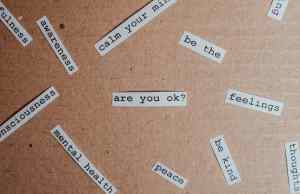September is National Suicide Prevention Month and is an important chance for each of us to understand how suicidal thoughts can be identified, prevented, and treated.
The resounding theme of National Suicide Prevention Month is to provide support and compassion to those struggling with mental health conditions or life circumstances that leave them vulnerable to suicidal thoughts and self-harm. By remaining vigilant and empathetic, we can all do more to help prevent suicide.
If you or a loved one is struggling with suicidal thoughts, please reach out to crisis support resources like the 988 Suicide & Crisis Lifeline.

The Importance of National Suicide Prevention Month
In 2008, September was designated as National Suicide Prevention Awareness Month to acknowledge those who have been affected by suicide as well as promote proactive measures to decrease future occurrences.
Suicide is widely regarded as an uncomfortable topic—so much so that almost half of people who die by suicide deny suicidal ideation in the weeks and months leading up to their death. This is why it’s so important to educate people on the prevalence of suicide and help those struggling feel less alone.
Suicide is a complex issue influenced by many factors, including:
- Mental health disorders
- Intense feelings of sadness, shame, guilt, worthlessness, or helplessness
- Abuse
- Pregnancy or loss
- Sexual orientation
- Imprisonment
- Financial woes
- Poor health/prognosis
- And more
National Suicide Prevention Month is a time dedicated to spreading information, learning, and destigmatizing the discussion of suicide. Suicide prevention helps keep those who feel isolated and hopeless from making a decision that will forever affect them and their loved ones. It’s also a straightforward way to destigmatize discussions surrounding self-harm and suicidal ideation and spread important resources that can help with treatment and recovery.
By taking time to self-educate about risk factors and preventative measures, we can each prepare ourselves to care for loved ones who may be considering ending their life or protect ourselves by knowing the warning signs and places for help.
Raising Mental Health Awareness
Some helpful steps you can take to raise awareness and draw attention to National Suicide Prevention Month are:
- Sharing resources on social media.
- Participating in community events and initiatives.
- Printing information to display in gathering places like foyers or offices.
- Informing those within your community, work environment, and friend circles.
- Wearing a ribbon to show your support. Yellow is the color used for National Suicide Prevention Month, though some organizations use blue and purple as well.
If you’re in a position to promote National Suicide Prevention Month at your workplace, university, school, or other location, you could make more of an impact on someone’s life than you realize.
Who Is at Risk for Suicide?
As mentioned above, some mental health conditions increase the risk of one developing self-harming, suicidal thoughts, or suicidality.
Dr. Caroline Fenkel is Chief Clinical Officer and Co-Founder of Charlie Health, a leading provider of virtual high-acuity mental health care for young people. According to Dr. Fenkel, age, family history, and more can be significant risk factors. “Suicide is one of the leading causes of death among young people, particularly those aged 10 to 24,” Dr. Fenkel states. “Mental health issues such as depression, anxiety, and substance abuse, along with past suicide attempts, family history of suicide, or access to firearms, further elevate the risk. Additionally, those struggling with sexual identity in unsupportive environments or experiencing bullying face even greater danger, particularly if they lack reliable support from friends and family.”
Depressive disorders, substance use disorder, and psychosis are some of the most common mental health contributors to suicidal ideation.
Beyond these groups, other commonly at-risk groups include:
- Adults aged 44-54, who account for 80% of all suicide deaths in the U.S.
- Elderly men ages 85 or older
- People with a history of social isolation and/or physical violence
- Those with access to life-ending means, such as firearms, drugs, or toxins
- LGBTQ+ youth, who are four times more likely to seriously consider a suicide attempt
- Veterans, who are 1 and a half times more likely to die by suicide than other Americans
People in these groups may not get the support they need from others on a variety of fronts, increasing their risk of suicide. They may also experience significant life transitions or experiences that create unique mental health challenges for them.
Signs and Symptoms of Suicidal Thoughts
It’s just as important to identify suicidal thoughts in others as it is yourself. Some warning signs that you or someone else is contemplating self-harm or suicide may include some combination of the following:
- Unexpected and intense shifts in mood, like elation or sadness
- Intense anxiety
- Changes in behavior, routines, or a disrupted sleeping pattern
- Reckless or frequent use of drugs or alcohol
- Giving away or selling belongings, or creating a will in an attempt to get their affairs in order
- Searching for a gun or substances (such as paracetamol/Tylenol) that could aid in a suicide attempt
- A recent history of depression, panic attacks, or antisocial behavior
- Consistent psychomotor agitation, such as pacing, twisting hair, or clenching fists
- Writing or otherwise saying goodbye to friends and loved ones without specifying why
- A substantial loss of enjoyment from activities like socializing, exercise, social interaction, or sex
Perhaps the most obvious way to identify suicidal thoughts is if you or someone else expresses a desire or wish to die. People can speak out of line sometimes, making morbid jokes about a desire to die or end their life when they’re frustrated or tired—but dark humor is not always so easily discernible from suicidal ideation. If you are concerned about someone close to you, consider checking in with them on a personal level or directing them to resources like the 988 Lifeline, where they get support from trained crisis professionals.
What Treatment Options Are Available to Someone Experiencing Suicidal Ideation?
Even though suicidal ideation may create feelings of hopelessness and despair, people suffering from these thoughts have many treatment options. Reaching out for a mental health provider’s assistance is the first step of treatment. With this in mind, some of the most commonly used therapeutic methods for treating suicidal ideation are:
- Cognitive behavioral therapy for suicide prevention (CBT-SP/CT-SP)
- Dialectical behavior therapy (DBT)
- Attachment-based family therapy (ABFT)
- Collaborative management and assessment of suicidality (CAMS)
- Prolonged grief therapy (PGT)
Additionally, psychiatric providers can be of great assistance for more severe or persistent cases of suicidal ideation. Successful psychiatric treatment may involve the following medications:
- Lithium
- Clozapine
- Ketamine
- Antidepressants, including SSRIs
Both therapists and psychiatrists are fantastic resources for finding relief and remission from suicidal ideation. However, for immediate assistance, a crisis line like 988 or a support center is a better option. Knowing who to call could save your life, or someone else’s.
Getting Involved: Spreading Hope and Awareness
There are many ways one can get involved in spreading hope and awareness—knowing about resources you can provide can help. Resources can range from time, energy, talents, skills, money, a platform, and so on.
You can donate time by attending a workshop that promotes self-preservation efforts. If you have the energy and ability to do so, consider participating in walks or runs that target suicide prevention awareness.
If you’re comfortable, you can also consider volunteering at a local crisis center. Many skills and talents are useful within local mental health centers, and they will often have programs to complement what you’re good at. Finally, you can use your social media platform to promote 988 lifeline initiatives such as the hashtag #BeThe1To Promote National Suicide Prevention Month or other helpful and informational posts provided by official sources.
Supporting Loved Ones During National Suicide Prevention Month
When it comes to providing support, Charlie Health’s Dr. Caroline Fenkel emphasizes the importance of nonjudgement. “Supporting someone who is struggling with suicidality requires a compassionate, patient, and non-judgmental approach.”
Before talking to someone about their mental health, knowing the warning signs of suicidal ideation is a great first step in supporting loved ones during National Suicide Prevention Month. Be aware of conversations with others that include expressing a desire to die, feeling like a burden, or an inability to tolerate emotional or physical pain.
Dr. Fenkel also has advice for approaching conversations about suicidality. “Encourage them to talk openly about their thoughts and emotions. Reducing the stigma associated with seeking help is crucial, as is making sure that at-risk individuals know about the resources available to them,” says Fenkel. “It’s crucial to listen actively and validate their feelings without immediately trying to fix the situation. Let them know you’re there for them and that their feelings matter.”
“If you’re concerned about their safety, it’s okay to ask directly if they’re thinking about suicide—it won’t put the idea in their head, but can be a crucial step in getting them the help they need.”
She also highlights the importance of connecting with a mental health professional. “Ensuring they have access to professional support is vital.” They may want to handle this on their own, but you can also offer to sit down with them while they look for a provider, or even offer to drive them to and from their first appointment.
How to Help Someone in Crisis
If you start seeing someone show behaviors that include withdrawing from friends and family, post-death plans such as giving items away, significant increase in drugs and alcohol usage, or an increase or decrease in eating and sleeping, then it might be helpful to incorporate the National Institute of Mental Health’s 5 Action Steps for Helping Someone in Emotional Pain:
- Ask. “Are you thinking about killing yourself?”
- Keep them safe. Reduce access to lethal items or places.
- Be there. Listen carefully and acknowledge their feelings without judgment.
- Help them connect. Call or text the 988 Suicide & Crisis Lifeline.
- Stay connected. Follow up with them and stay in touch after a crisis.
It can be difficult to support someone as they go through such a challenging time, so don’t forget to get help for yourself as well, such as speaking with a mental health professional about what you’re going through.
Promoting Suicide Prevention Strategies
One way to promote suicide prevention strategies is to share your story. If you’ve struggled with suicidal thoughts or feelings personally, feel comfortable opening up about it, and the setting is appropriate, share that with others and recognize that things can indeed improve. As hopelessness and loneliness are factors for suicidal ideation, by sharing your story, you can provide hope and understanding to people who are currently struggling.
It’s also important to know what options are available for professional mental health help. Dr. Fenkel states that “Preventing suicide requires both immediate interventions and sustained, long-term support.”
“Long-term strategies are essential for reducing the risk of suicide. Access to evidence-based treatment, particularly at higher levels of care, plays a vital role in suicide prevention. These levels of care include:
- Inpatient Care: This is the most intensive level of care, where individuals stay in a hospital or residential facility for 24/7 monitoring and treatment. It is typically used for those experiencing severe mental health crises or requiring constant supervision.
- Partial Hospitalization Programs (PHP): PHP is a step down from inpatient care, offering intensive treatment during the day while allowing patients to return home in the evening. It provides a structured environment with various therapeutic activities and sessions, making it suitable for those who need significant support but do not require round-the-clock care.
- Intensive Outpatient Programs (IOP): IOP offers a lower level of intensity compared to PHP, with patients attending therapy and treatment sessions several times a week. It is designed for individuals who need more support than traditional outpatient therapy but do not require the intensity of PHP or inpatient care.
“These settings provide comprehensive support by addressing the root causes of distress and equipping individuals with the tools needed to manage their mental health. Within these structured environments, group sessions allow individuals to build strong, supportive relationships and develop crucial coping skills, further enhancing their ability to navigate challenges and reduce suicide risk.”
You can also use platforms like social media to promote suicide prevention. If you do, consider using your resources to support initiatives that target:
- Stable housing
- Organizational policies that support fair and safe work environments
- Lower accessibility of lethal means
- Accessible mental health coverage
- System changes to include safer care for those at risk
- Educational programs that target resilience, parenting skills, and social emotional skills
- Training professionals to identify those at risk
- Substance abuse and dependency reduction
Finally, Fenkel offers that engaging the community in providing mental health support can be a great way to spread information and support. “On a broader level, schools and communities have a significant role to play. By offering mental health education, creating environments where young people feel connected and supported, and intervening early when signs of distress appear, they can make a substantial impact in preventing suicide.”
Resources for Mental Health Support
Each of these issues can individually contribute to mental health issues like suicidal ideation. There are also other resources you can highlight that provide crisis services to those who need them. The following are suicide and crisis lines available year-round:
- 988 Suicide and Crisis Lifeline: Dial 988 *Veterans, press 1 when calling*
- Crisis Text Line: Text HOME to 741741
- Veterans Crisis Text Line: Send a text message to 838255
- Vets4Warriors: Dial 1-855-838-8255
- SAMHSA Line for Treatment Referral (Substance Abuse): Dial 1-800-662-HELP (4357)
- The Trevor Project: Dial 1-866-488-7386
- Charlie Health’s Admission Line: Dial (866) 484-8218
If you or someone you know is in immediate danger due to suicidal ideation or is in danger of harming themselves or others, 911 is a quick and reliable way to connect with first responders. It can be difficult to ask for help—but doing so could save your life.
How Do I Ask for Help? Accessing Professional Help
When it comes to mental health conditions, it’s not uncommon for people to go back and forth on whether or not to seek out professional assistance, despite mental health services being an important form of medical treatment.
Asking for help with mental health challenges and conditions that are causing emotional distress is important. Steps to consider when asking for help include:
- Being honest and open about the struggles you’re facing related to suicidal thoughts, actions, or self-harming behaviors.
- Creating enough time and space to reach out for assistance. You don’t want to feel rushed or pressured.
- Finding a mental health professional who can help and offer compassion and empathy. Thriveworks has therapists and psychiatric professionals who are available to meet with you, often within a week of scheduling.
- Remembering that feelings of guilt, inadequacy, and shame aren’t productive or realistic emotions to place on yourself.
There’s nothing wrong with seeking out mental health services—anyone can benefit from talking to a provider. It does not mean that someone is weak, dependent, or incapable of solving their mental health conditions or concerns.
Scheduling your first psychiatry or therapy session means you are prioritizing your emotional well-being and placing your needs first so that you can remain independent, successful, and (most importantly) happy in your daily life.
+++
Dr. Caroline Fenkel, Chief Clinical Officer and Co-Founder of Charlie Health, is a pioneer in advocating for and implementing evidence-based mental health treatment strategies for those most at risk for suicide. Charlie Health is a leading provider of virtual high-acuity mental health care for young people.













